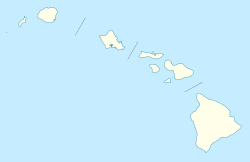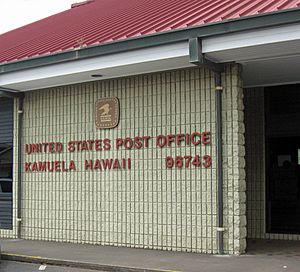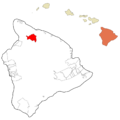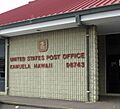Waimea, Hawaii County, Hawaii facts for kids
Quick facts for kids
Waimea, Hawaii
Kamuela
|
|
|---|---|
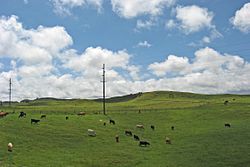
Some cattle pastures just outside Waimea, August 2007
|
|
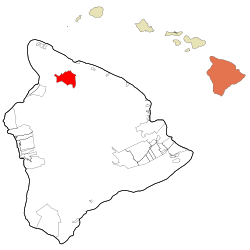
Location in Hawaii County and the state of Hawaii
|
|
| Country | United States |
| State | Hawaii |
| County | Hawaii |
| Area | |
| • Total | 39.42 sq mi (102.11 km2) |
| • Land | 39.38 sq mi (102.01 km2) |
| • Water | 0.04 sq mi (0.10 km2) |
| Elevation | 2,670 ft (810 m) |
| Population
(2020)
|
|
| • Total | 9,904 |
| • Density | 251.47/sq mi (97.09/km2) |
| Time zone | UTC-10 (Hawaii-Aleutian) |
| ZIP code |
96743
|
| Area code(s) | 808 |
| FIPS code | 15-78500 |
| GNIS feature ID | 2414164 |
Waimea is a town in Hawaii County, Hawaii, United States. It is located on the island of Hawaii, also known as the Big Island. The name Waimea means reddish water in the Hawaiian language.
Waimea is a very important place for ranching and cowboy culture in Hawaii. The Hawaiian cowboys are called paniolo. The town is also known as Kamuela, which is the official name used by the U.S. Post Office. This is because there is another town named Waimea on the island of Kauai, and each state can only have one post office with the same name.
One of the most famous places in Waimea is the Parker Ranch. It is one of the largest privately owned cattle ranches in the United States. Every year, a big rodeo is held there on the Fourth of July. Waimea also hosts the Waimea Cherry Blossom Heritage Festival in February, which is a popular event.
Waimea is a hub for astronomy. It is home to the main offices of two large observatories that are located on Mauna Kea. These are the W. M. Keck Observatory and the Canada–France–Hawaii Telescope. The International Lunar Observatory Association also has its headquarters here.
The town is also known for its excellent schools. These include Hawaii Preparatory Academy and Parker School.
Contents
History of Waimea
Waimea has a rich history, from ancient Hawaiian times to its role in modern astronomy.
Early Hawaiian Life
Long ago, the area around the Kohala mountains was home to many native Hawaiians. They grew their own food and made things like kapa (cloth from tree bark). They also built their homes using thatching techniques.
When Europeans arrived, they cut down most of the sandalwood forests. This made the land perfect for animals to graze. In 1793, Captain George Vancouver gave California longhorn cattle as a gift to Hawaiian King Kamehameha I.
The First Cowboys
In 1809, a man named John Palmer Parker came to the area. He started working for the king to hunt and manage the wild cattle. The cattle population had grown very large. In 1815, Parker married Kipikane, who was the daughter of an important chief. Together, their family started what is now the famous Parker Ranch.
In the early 1800s, Spanish vaqueros (cowboys) arrived from other parts of the Americas. They brought horses and taught Hawaiians how to ride and rope cattle. By 1836, the island had skilled cowboys. The Hawaiian culture and the Spanish vaquero culture blended together. This created a unique type of cowboy known as the paniolo.
Waimea During World War II
During World War II, the prices for beef and vegetables went up. This led many farmers to grow crops like corn, beets, and cabbage. The amount of land used for farming and ranching grew a lot during this time.
Many soldiers were stationed in Waimea at a place called Camp Tarawa. After the war ended and the military left, Waimea gained some new facilities. These included an entertainment center, the Kahilu Theatre, and an airstrip, which is now the Waimea-Kohala Airport.
Geography and Climate
Waimea is located in the northern part of the island of Hawaii. It sits at an elevation of about 2,676 feet (816 meters) above sea level. The town is at the southern base of Kohala, which is the oldest volcano on the island. It is also near the northwestern base of Mauna Kea, the tallest volcano.
The post office name "Kamuela" for Waimea comes from the Hawaiian name for "Samuel". This was in honor of Samuel Parker, who was the grandson of John Parker.
Hawaii Route 19 goes through Waimea. It leads southeast to Hilo and southwest to Kailua-Kona. Hawaii Route 190 also starts in Waimea and offers a shorter route to Kailua-Kona.
Waimea covers an area of about 39.4 square miles (101.9 square kilometers). Most of this area is land.
Waimea's Weather
Waimea has a warm summer Mediterranean Climate. This means it has warm, dry summers and mild, wet winters. The town is located where the wet and dry sides of the Big Island meet. Because of this, the weather can change very quickly, even within a short distance.
| Climate data for Waimea | |||||||||||||
|---|---|---|---|---|---|---|---|---|---|---|---|---|---|
| Month | Jan | Feb | Mar | Apr | May | Jun | Jul | Aug | Sep | Oct | Nov | Dec | Year |
| Mean daily maximum °F (°C) | 72.6 (22.6) |
72.2 (22.3) |
72.5 (22.5) |
73.3 (22.9) |
74.0 (23.3) |
74.5 (23.6) |
74.6 (23.7) |
75.7 (24.3) |
76.8 (24.9) |
76.8 (24.9) |
74.7 (23.7) |
72.1 (22.3) |
74.2 (23.4) |
| Mean daily minimum °F (°C) | 50.4 (10.2) |
50.6 (10.3) |
51.7 (10.9) |
52.8 (11.6) |
54.3 (12.4) |
55.4 (13.0) |
56.4 (13.6) |
57.1 (13.9) |
56.9 (13.8) |
55.2 (12.9) |
54.2 (12.3) |
52.3 (11.3) |
53.9 (12.2) |
| Average rainfall inches (mm) | 4.74 (120) |
3.76 (96) |
3.84 (98) |
3.08 (78) |
1.74 (44) |
1.34 (34) |
1.97 (50) |
2.27 (58) |
0.89 (23) |
1.89 (48) |
2.94 (75) |
4.22 (107) |
32.68 (831) |
| Source: http://www.wrcc.dri.edu/cgi-bin/cliMAIN.pl?hi3077 | |||||||||||||
People of Waimea
| Historical population | |||
|---|---|---|---|
| Census | Pop. | %± | |
| 2000 | 7,028 | — | |
| 2010 | 9,212 | 31.1% | |
| 2020 | 9,904 | 7.5% | |
| U.S. Decennial Census | |||
In 2020, the population of Waimea was 9,904 people. The town has grown over the years. In 2000, there were 7,028 people, and in 2010, there were 9,212.
Waimea is a diverse community. Many different groups of people live there. The average household in Waimea had about 2.95 people. About 39% of households had children under 18 living with them. The median age in Waimea was 36 years old. This means half the people were younger than 36, and half were older.
Arts and Culture
Waimea is usually a quiet town, but it comes alive during its special events. The Waimea Cherry Blossom Heritage Festival is a big celebration held every year on the first weekend of February. People enjoy the beautiful cherry blossoms and cultural activities.
Another major event is the annual rodeo and Horse Races. These are held at Parker Ranch every year on July 4th. It's a fun time for everyone to watch cowboys and horses.
Notable People
- Michael Rikio Ming Hee Ho – An American conceptual artist.
- Sonny Lim – A talented musical artist.
Images for kids
See also
 In Spanish: Waimea (condado de Hawái) para niños
In Spanish: Waimea (condado de Hawái) para niños


